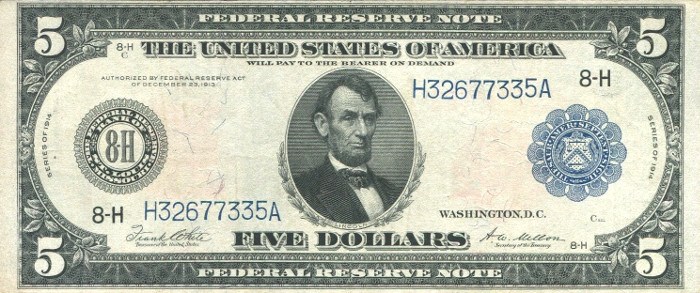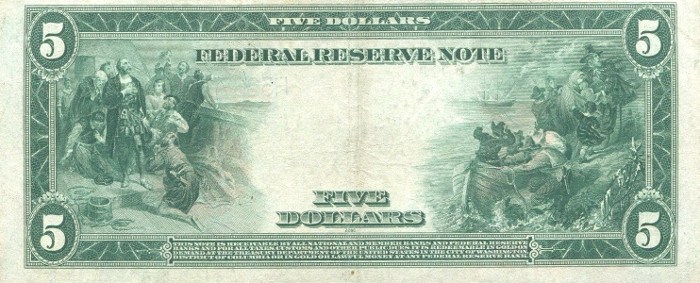The 1914 5 dollar bills are large-size notes that can be valuable. Rare varieties exist and they yield higher prices. Continue reading to learn more about these bills.


The obverse side of the bill features a portrait of Abraham Lincoln. The reverse side of the bill features two separate images- on the left there is an image of Christopher Columbus surveying newly discovered land, and on the right there is an image of the Pilgrims arriving to America.
Specifications
| Denomination: | $5.00 USD |
| Type: | Federal Reserve Note |
| Portrait: | Abraham Lincoln |
| Series: | Series of 1914, Blue Seal |
Value
Most of these bills in circulated condition will be worth more than their face value of $5. Bills in high condition grades will sell for a lot more money.
Most 1914 $5 blue seal bills are worth around $60-75 in very good condition. In very fine condition the value is around $115-125. In extremely fine condition the value is around $185-225. Uncirculated bills with a grade of MS 63 can sell for around $375-550.
Rare Varieties
There are a few rare varieties that you should look for.
Bill no. F-863B issued from the Federal Reserve Bank of Richmond with the signatures of White and Mellon is the most valuable variety. This bill is worth around around $400 in very good condition. In very fine condition the value is around $1,250. In extremely fine condition the value is around $2,000.
Bill no. F-889 issued from the Federal Reserve Bank of San Francisco with the signatures of Burke and Glass is worth around around $135 in very good condition. In very fine condition the value is around $300. In extremely fine condition the value is around $950.
Lastly bill no. F-890 issued from the Federal Reserve Bank of San Francisco with the signatures of Burke and Houston is worth around around $125 in very good condition. In very fine condition the value is around $300. In extremely fine condition the value is around $950.
Note: Valuable bills should be placed inside large-size currency holders.
Grading System
Very good- A circulated note that has considerable wear to it. There might be one or two tears on the edge of the note. The note may be discolored, dark in appearance, or limp.
Very fine- A note that has been in circulation but not for a long time. The note is still relatively crisp. There may be some creases, folds, or light smudges.
Extremely fine- A note that shows small signs of having been in circulation. The note will be bright and it will have almost all of its original crispness. There might be one or two minor creases or folds but there are no stains, discolorations, or tears.
MS 63 choice uncirculated- A note that shows no signs of ever having been in circulation. The note still has its original crispness. The note is also well-centered.
Sources:
A Guide Book of United States Paper Money
See also:
1907 Five Dollar Bill 1928 Five Dollar Bill 1929 Five Dollar Bill
